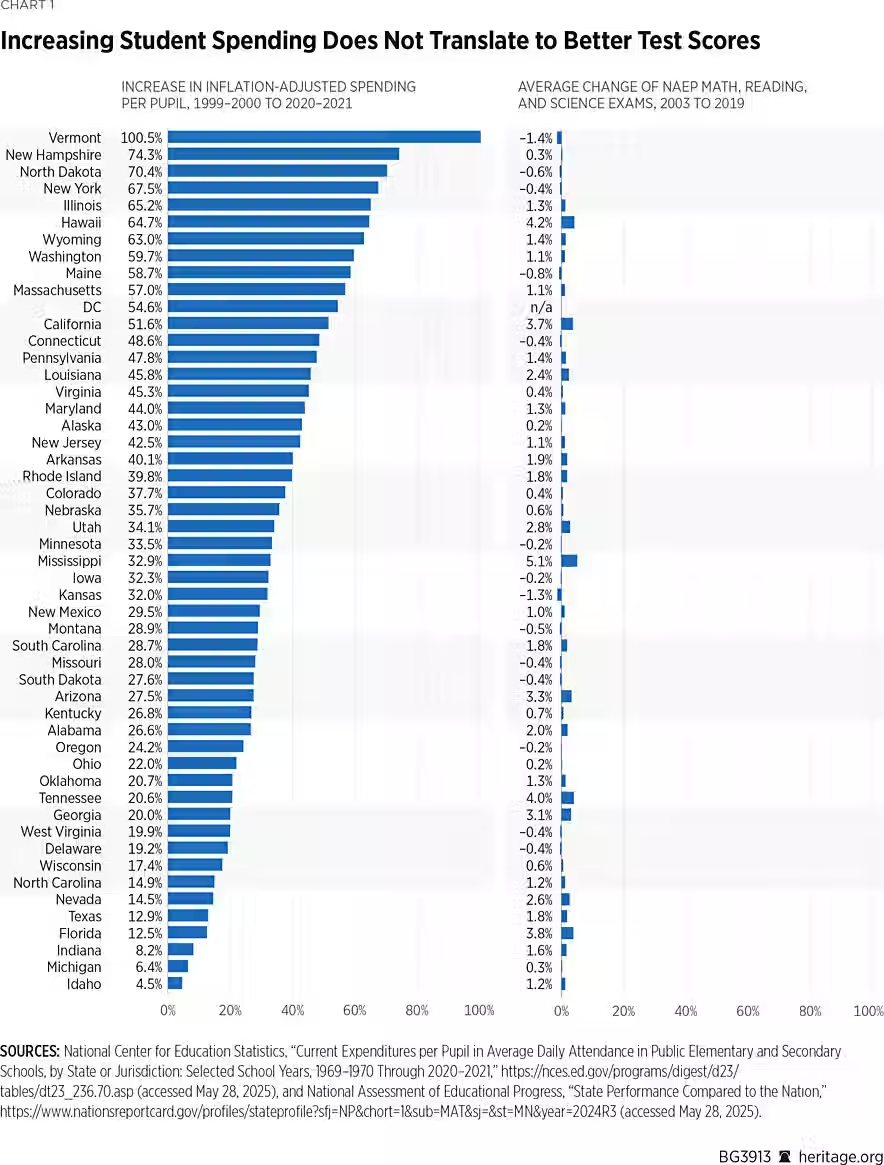States spent more, kids learned less: Will choice revive education?
- Joanne Jacobs

- Jul 10
- 2 min read
Spending more on schools -- 37 percent more above inflation over 20 years -- led to a 1 percent gain in achievement. Adopting academic standards and accountability exams had little effect. Education reformers "brought a technocratic knife to a political gunfight," writes Matthew Ladner of the Heritage Foundation's Center for Education Policy.
But the future could be brighter, he predicts. New choice programs will make it possible for educators to create new schools and services and families to choose what meets their children's needs.
All 50 states increased inflation-adjusted per pupil funding, starting in 1999 and 2000, Ladner writes. Spending increases did not correlate with student achievement. Vermont doubled spending, and saw a 1.4 percent decline in NAEP scores. Idaho spent only 5 percent more and saw a 1 percent gain, equal to the national average.
Mississippi, which raised spending by a third, made the biggest gains (5 percent) thanks to a comprehensive state initiative to improve reading instruction. Hawaii, which raised spending by two-thirds, gained 4.2 percent. But Tennessee (20.6 percent more spending) and Florida (12.5 percent) did almost as well.

Test-based accountability systems were subverted by "education unions and their allies and proxies," Ladner writes. Most state "systems morphed into hollow bureaucratic compliance rituals delivering participation trophies rather than meaningful consequences."
Many states lowered the scores needed to achieve "proficiency," persuading parents their children were doing well, he writes. Accountability systems became "weapons of mass deception."
Ladner sees a new era of "education choice" rather than just "school choice." Using education savings accounts and scholarships, parents will be able to choose among education methods, using a variety of information sources to choose best-fit programs and enrichment opportunities for their children.






Adjusted for inflation, the United States spends 3.5 to 4 times as much on education as it did in the 1960's, and over the last 25 years, testing has shown slight, or no, or losses in reading, writing, and math...
The 2024 NAEP results for 8th graders in the US (12th graders were NOT tested last year, btw) shows that only 20-25% are proficient (i.e. - at grade level) in math, and approximately 40% are proficient in language arts (i.e. - reading, writing, spelling, etc)...
I suspect if 12th graders would have been tested, the results would have been sub-atomic compared to the 8th graders scores...
<ugh>
The more complicated school choice becomes, they more failures will occur and the more the students with tiger moms will be at the top of everything.
What other industry brags about increasing per unit costs?
Why not allow children to take the GED at any age and subsidize apprenticeship training? Call it "education" to get around child labor laws. Normal people want to be useful.
North Dakota was a high-performance public school system in 1992: numerous small school districts, high NAEP scores, low per-pupil revenue. Then oil revenue flooded in and overall system productivity collapsed.
Parents being well informed should be key -- which could mean a new, larger audience for educational journalists like you, Joanne!